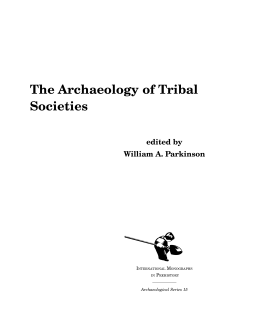
Additional Information
Book Details
Abstract
Anthropological archaeologists have long attempted to develop models that will let them better understand the evolution of human social organization. In our search to understand how chiefdoms and states evolve, and how those societies differ from egalitarian 'bands', we have neglected to develop models that will aid the understanding of the wide range of variability that exists between them. This volume attempts to fill this gap by exploring social organization in tribal - or 'autonomous village' - societies from several different ethnographic, ethnohistoric, and archaeological contexts - from the Pre-Pottery Neolithic Period in the Near East to the contemporary Jivaro of Amazonia.
William A. Parkinson is Associate Curator of Eurasian Anthropology at the Field Museum of Natural History in Chicago, Illinois.
Table of Contents
| Section Title | Page | Action | Price |
|---|---|---|---|
| The Archaeology of Tribal Societies | i | ||
| Copyright | ii | ||
| Table of Contents | iii | ||
| List of Contributors | v | ||
| Preface and Acknowledgements | vii | ||
| Chapter 1. Introduction | 1 | ||
| Chapter 2. From Social Type to Social Process | 13 | ||
| Chapter 3. The Tribal Village and Its Culture | 34 | ||
| Chapter 4. The Long and the Short of a War Leader’s Arena | 53 | ||
| Chapter 5. Inequality and Egalitarian Rebellion, a Tribal Dialectic in Tonga History | 74 | ||
| Chapter 6. The Dynamics of Ethnicity in Tribal Society | 97 | ||
| Chapter 7. Modeling the Formation and Evolution of an Illyrian Tribal System | 109 | ||
| Chapter 8. Mobility and the Organization of Prehispanic Southwest Communities | 123 | ||
| Chapter 9. Building Consensus | 155 | ||
| Chapter 10. Fractal Archaeology | 173 | ||
| Chapter 11. Material Indicators of Territory, Identity, and Interaction in a Prehistoric Tribal System | 200 | ||
| Chapter 12. Hopewell Tribes | 227 | ||
| Chapter 13. The Evolution of Tribal Social Organization in theSoutheastern United States | 246 | ||
| Chapter 14. Mesoamerica’s Tribal Foundations | 278 | ||
| Chapter 15. Early Neolithic Tribes in the Levant | 340 | ||
| Chapter 16. A Neolithic Tribal Society in Northern Poland | 372 | ||
| Chapter 17. Some Aspects of the Social Organization of the LBK ofBelgium | 384 | ||
| Chapter 18. Integration, Interaction, and Tribal ‘Cycling' | 391 |
